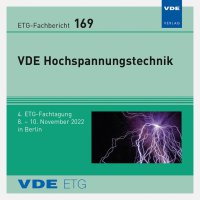Space Charge Behaviour in Silicone Rubber under the Influence of pre-Stress
Konferenz: VDE Hochspannungstechnik - 4. ETG-Fachtagung
08.11.2022 - 10.11.2022 in Berlin, Germany
Tagungsband: ETG-Fb. 169: VDE Hochspannungstechnik 2022
Seiten: 7Sprache: EnglischTyp: PDF
Autoren:
Roesch, Felix; Plath, Ronald (Technical University of Berlin, Germany)
Inhalt:
For long distances High Voltage Direct Current (HVDC) is getting a common transmission mode. Polymeric cables are used for transmission instead of overhead lines in specific situations, e. g. in urban regions, off-shore, public desire. In contrast to AC systems, HVDC cables suffer from space charge phenomena, which may critically alter the electric field within the cable insulation. Even more attention has to be paid to multi-dielectric systems as they can be found in cable accessories. The steady state electric field distribution under HVDC condition within cable insulation systems depends on geometry, the conductivity of the insulation materials and on space charge distribution. To calculate the electric field distribution within complex arrangements with the help of simulation tools the field and temperature dependant conductivities of the involved insulation materials and the space charge distribution within the insulation system must be known. Consequently, in the last two decades much work focused on space charge measurement and the determination of temperature and electric field dependant apparent conductivity. Less attention has been paid to the influence of pre-stress on the mentioned quantities. During operation the temperature of the inner conductor and the resulting temperature gradient inside the insulation is changing permanently due to the variation of the load current. In this paper these temperature variations will be referred to temperature profiles. In addition, transmission lines are switched off for maintenance purposes, accompanied by depolarisation processes, and are switched on again for operation afterwards. These two conditions result in consecutive temperature profiles interrupted by depolarisation processes during switch-off periods. The space charge distribution can be influenced by preceding stress. To investigate the possible influence pre-stress on HVDC-insulation materials space charge measurements using the Laser Induced Pressure Pulsed (LIPP) method are conducted on silicone rubber (SiR) plate specimen. A temperature profile with isothermal conditions of 20 °C, 65 °C and 20 °C is applied on the sample. Then voltage is switched off and the depolarisation processes are observed. After depolarisation cycle another polarisation phase is applied. The results show the difference in space charge behaviour between fresh samples and prestressed samples. The influence of pre-stress by means of consecutive temperature cycles can be explained considering temperature dependent injection rate and mobility. The influence of pre-stress by means of sequential polarisation phases is described. To fully understand the processes further work is required.


